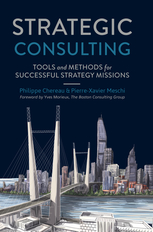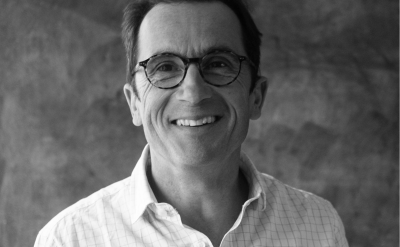Actualités

"What strategy for strategy consulting ?" by Yves Morieux (SK 1983) Senior Partner and Managing Director, Boston Consulting Group.
But your job also guarantees one of the bumpiestrides of all. Few professions are as widely criticized as consulting. Consultants are said to be in the business of borrowing (or stealing, or charging for) someone’s watch to tell them the time. Blamingthe consultant is one of the most effective ways to reach a corporate consensus. What about strategy itself? In the business world, what can be heard most often—people praising the company’s strategy, or people criticizing it? As a consultant in strategy you are really looking for trouble.
That is why this book is important: it is a companion that will help overcome many of the hurdles that stand in the way of the great cause you serve. The book lets you into the dialogue between theory and practice, giving you the scientific underpinning you need to carry out successful strategy consulting assignments. This dialogue is now more necessary than ever since strategy, even in management literature, has become increasingly controversial: Is strategy about long range planning or diagnostic? Should we go for the position-based view, or the resource-based view? Each approach gives rise to new debates and dichotomies. The number of strategy frameworks has increased tenfold over the last 40 years. Which approach should be used and when? The underpinning theories in the book provide practical help for navigating different strategy tools and client issues.
The ride is getting even bumpier as the very nature and usefulness of strategy are challenged by the volatility, uncertainty, complexity, and ambiguity of the business landscape (VUCA). According to the Complexity Index developed with my teams at The Boston Consulting Group Institute for Organization, business complexity has multiplied six-fold since 1955.
Organizations respond to this external complexity by becoming more complicated, piling on structures, processes, scorecards, committees, and systems. According to our measurements, organizations have become over 35 times more complicated over the same period, choking productivity and disengaging people. Business complexity can only keep growing, since it arises from the multiple requirements companies must meet to create value for a growing number of stakeholders. These include customers, shareholders, and employees as well as many political, regulatory, and compliance authorities. Each of these groups has its own requirements, and companies can afford less and less to satisfy one group at the expense of
the others. These requirements have become more numerous, are changing faster, and are often mutually conflicting. In 1955, companies typically had to meet between 4 and 7
performance imperatives. Now they need to satisfy between 25 and 40—of which almost half may be contradictory. This was certainly not the case back in 1955. In order to attract customers, keep customers and build competitive advantage, companies now need greater speed and reliability, innovation and efficiency, global consistency and local responsiveness, lower cost and higher quality. Companies also face greater uncertainty. They need to be able to detect, interpret and act upon weak signals; my teams and I have also measured the decline in the signal-to-noise ratio companies can rely on.
My colleagues at The Boston Consulting Group Henderson Institute have measured the evolution of volatility by counting the number of changes in the ranking of companies, for instance for sales or market capitalization. Today’s volatility is much greater than during the 1950-1959 period. The predictability of higher profitability based on market share leadership has been divided by 5. VUCA is a proven fact, not a buzzword.
Do organizations even need strategy, let alone strategy consultants, when what happens is so unpredictable, complex and fast changing? I must admit that, after more than 30 years in this business, I came close to saying that they don’t. But I remembered the joke about strategy consultants stealing their clients’ watches. I realized that saying there was no point in strategy would have been like saying “What’s the point in having a watch since time changes all the time?” Like many catchy paradoxes this does not stand up to scrutiny. What makes it useful to know the time is not the time, it is that we all share the same time all the time. This enables us to synchronize, live and coordinate with one another. What matters with strategy is not the strategy itself, it is the collective energy and intelligence that its development and achievement enables—including through disruptive moves that prove smart in the end because the whole organization is engaged and succeeds. This collective engagement is precisely what helps organization deal with greater business complexity.
The more complex and turbulent the business world, the less we can rely on standard or predefined criteria for making important decisions. Is it speed to market, market share, growth, profitability, competitive pressure, an ad hoc combination of these, or something else? Only a conversation—with all relevant roles and levels in the organization—will help build the pertinent criteria and give the answer. What I call “conversation”, however, is not a cozy chat: this conversation must be led, structured, factual and grounded. Frameworks, like those provided in this book, help to guide and structure the argument. They help identify the data necessary to engage in factual discussion, a world beyond opinions or gut feeling. The
underpinning theories described in the book provide grounding by helping to explain the often implicit assumptions made when using one framework or another. Enabling a strategy conversation that is structured, factual and grounded makes this book particularly valuable in today’s business landscape. As for consulting itself, there will be a market as long as 50% of companies are below the median—which will hold true in the foreseeable future.
No doubt then, strategy consulting remains a useful business. But what is the sustainable competitive advantage of strategy consultants in this business? On what bases do they build advantage ? Do we consultants know the client’s company better than the client or other consultants do? For sure we may discover something the client had not realized. However, the client’s company is constantly evolving; things happen that we are not always aware of. Do we know their industry better than clients do? Not really—there is always somebody in the client company or its competitors who knows something about the industry that we don’t. Do we know our frameworks better than the client does? Yes, hopefully. But clients also know the frameworks of other consultants. Or is it that we have longer days than clients, or other consultants? I doubt it—I have seen many clients stay late at night and have long meetings on weekends. Some have more than 50 hours of meetings per week, and then there is the real work and homework. Of course, we can skip sleeping; many of us have done this, sometimes for days....but unfortunately, there are only 24 hours in a day. What about education, hiring MBAs? This is exactly what clients do, and theyalso hire competent graduates in many other specialized areas. Perhaps we should rely on being uniquely clever then? That would be a risky bet since, as Descartes wrote in his tongue-in-cheek opening of Discourse on the Method,“Of all things, good sense is the most fairly distributed”. So what exactly is our sustainable competitive advantage ? The answer is very simple: it is work, a way of working which uniquely matches the essence of our profession. The crux of our profession is
producing insights to resolve business problems. These range from strategy formulation to strategy execution, from transformation to corporate development, from capability-building to post-merger integration. We need to work in a way that systematically produces more insights and that proves more useful in solving business problems. Our way of setting targets and evaluating work must encourage creativity. Beyond individual creativity, we need to make sure the team is organised in a way that allows for insights. Some ways of organizing a team into “modules” can be sterile—while others are fertile. Having a module for product analysis and another for competition analysis is likely to be much less insightful than having a module
to understand the full customer path for each segment. The sequence of assignments also drives insight generation, it must allow for opening up at the beginning and convergence towards the end. Sustainable competitive advantage in strategy consulting requires the business and its operating models to enable the production of superior insights.
For large consulting firms, the business model is likely to become a constellation of interconnected and very specialized units that share an umbrella brand. How can a consultant remain a generalist, a man of all trades in strategy, when clients have access to all consultants in the world ? Adam Smith’s theorem in the Wealth of Nations—specialization is limited by the extent of the market—also holds true for strategy consulting. Specialization is not an option when the market is global. All of us must become part of the handful world champions in one area.
Given the rapid changes in the business land scape, the operating model must enable innovation in approaching and solving client problems. Otherwise, solutions will fail to ensure advantage for the client company and frustrate its customers. These solutions must be practical and based on proven results. If not, your client will not be reassured and engaged. The operating model must also ensure that consultants learn and grow throughout assignments. This is what matters to them, otherwise they will go elsewhere. And, of course, the model must also foster productivity among the consulting teams. Without sufficient productivity, it will be impossible to get the necessary surplus to invest and prepare the future.
However, all these requirements are contradictory. Innovative approaches are hardly proven, practical and battle-tested solutions. Consultants will learn and grow only if they do things they have never done before. After 5 market segmentation assignments, a consultant needs to work on a merger to learn about corporate development; even if he or she never becomes an expert in this, it is part of the expected common knowledge, a prerequisite to moving into a more senior role at some point. Nevertheless, this consultant will be much less productive in this assignment than another colleague who has already worked on 5 mergers. So what should you do in this case? This is the complexity faced every day in strategy consulting. When you manage to reconcile productivity, learning, innovation and practicality, you break compromises. Breaking these compromises unleashes new value for all stakeholders. This new value fuels sustainable growth... and you will have even more opportunities to make the world better.
 Yves Morieux is a senior partner and managing director in the Washington, D.C. office of The Boston Consulting Group (BCG). He leads the BCG Institute for Organization and is a BCG Fellow. He divides his time between conducting research and working with the CEOs and leadership teams of the most prominent companies around the world.
Yves Morieux is a senior partner and managing director in the Washington, D.C. office of The Boston Consulting Group (BCG). He leads the BCG Institute for Organization and is a BCG Fellow. He divides his time between conducting research and working with the CEOs and leadership teams of the most prominent companies around the world.




